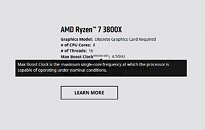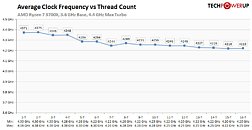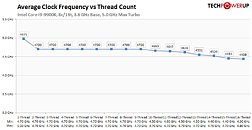Monday, August 12th 2019

AMD Updates Ryzen Product Pages to Elaborate on "Max Boost Clocks"
AMD over the weekend updated the product-pages of its Ryzen processors on the company website to be very specific about what they mean by "Max Boost Clocks," that are advertised almost as extensively as the processor's main nominal clock-speeds. AMD describes it has "the maximum single-core frequency at which the processor is capable of operating under nominal conditions." We read into this as the highest boost-clock given to one of the cores on the processor.
If you've been reading the "clock-frequency and boost analysis" charts in our processor reviews, you'll know that AMD processors spread their boost frequency progressively across cores during a multi-threaded workload that scales across all cores. At any given time, only one of the cores is awarded the highest boost clock, and while the other cores too get boosted beyond the nominal clock-speeds, they are in slight decrements of 25-50 MHz. The graph below is from our Ryzen 7 3700X review. The second graph below is from our Core i9-9900K review, which too shows only one of the cores getting the max boost frequency, and the remaining cores getting lower boost clocks, although the graph looks flatter.
Source:
squidz0rz (Reddit)
If you've been reading the "clock-frequency and boost analysis" charts in our processor reviews, you'll know that AMD processors spread their boost frequency progressively across cores during a multi-threaded workload that scales across all cores. At any given time, only one of the cores is awarded the highest boost clock, and while the other cores too get boosted beyond the nominal clock-speeds, they are in slight decrements of 25-50 MHz. The graph below is from our Ryzen 7 3700X review. The second graph below is from our Core i9-9900K review, which too shows only one of the cores getting the max boost frequency, and the remaining cores getting lower boost clocks, although the graph looks flatter.



134 Comments on AMD Updates Ryzen Product Pages to Elaborate on "Max Boost Clocks"
as for poor overlooks this is what happens when manufacturers are forced to run their chips at close to their real abilities as opposed to market segment speeds.. its as it should be..
trog
Sure, it might not be a well threaded game or even need the extra cores, but the boosting cores hit 4.2-4.3GHz only.
As such, something isn't right.
In fact, I think we can safely say only Nvidia has its GPU boost story in good order. As in: you always get an advertised clock, and most of the time, you get much higher clocks. Even if you nearly cook the GPU it will still run base clock or you'll be using it completely out of spec.
Perhaps what we need is an industry standard wrt boost clocks. I could imagine you'd set that at something like a total achieved frequency across all available threads divided by number of threads. And when you do it like that, suddenly AMD doesn't look all that bad. Another approach could be the total deviation from advertised clocks - again, if you'd put Intel versus AMD spec sheet and reality; AMD will be coming out much better.
Let's not go blind on that peak clock number and define something around thát. I really don't like Intel's Turbo and the spec sheet trickery they've deployed over the years (and how recent parts handily turn the 'headroom' into 'used room' and how CPUs royally boost beyond TDP on stock bioses). They're playing the game for marketing, AMD is just bad at it (once again... it never ends does it) and you're right they've left a gap here for a lawsuit. But AMD does deploy a much better type of boost.
I mean for this example here, what should AMD advertise, 4375 mhz on the box instead of 4.4? 25 mhz... :oops:
As for the 'need' to see what conditions are required to get the advertised boost clocks...maybe. Maybe not... isn't the actual defining factor for a CPU in the end performance? You cannot grasp CPU performance based on clocks alone, nor could you do it based on the advertised turbo/boost clock of a spec sheet, after all there are barely any use cases that only hit one core.
Its already shady as hell. And the only reason it was 'stable for years' is because Intel was the only one playing the game.
Edit:
Definitions, specifications and limits are not the problem. Adherence to these is. For example:
- I can see from specs that my i5 8400 has a 100C temperature limit and power limit 65W - with short-term (8 seconds) extended 81W limit on top of that - where both work as expected.
- Similarly, my 3600X has a 95C temperature limit that works as expected but a 95W power limit that never seems to be reached, nevermind the extended 128W limit. At the same time, CPU is a bit short of its spec boost clock.
A 1-core turbo is also not very relevant, its a remnant from the days when a quad core was considered high end and many applications were single threaded. The number means effectively nothing today.
I fully expect AMD to figure out the boost in BIOS at one point but a month after release seems like it would be an appropriate time already.Remember all the flak Intel got for not publishing static frequency tables? :)
Another problem by the way is already apparent if you look at how TDP is defined and how it is used in practice.Right! Well then... time to redefine things no? Get with the times. We're looking at 16 thread consumer CPUs nowadays.
Yeah, Intel fucked up with TDP for K models... and AMD decided to follow suit.
And Intel didn't fuck up at all, this is working as intended, make no mistake. Long term strategy for 'sustainable growth' is what they call this in business. There are no mistakes, there is only carefully screwing you over every time and getting away with it.
Spec boost clock is basically for a single thread. Spec base clock is for all-core load. And all of the listed CPUs will reach that at stock.
8700K base 3.7 and boost 4.7
7700K base 4.2 and boost 4.5
9900K base 3.6 and boost 5.0
Yes, there are cases where this is not reached due to power limit, mostly due to full AVX2 load although at stock settings with stupid TDP configuration they will do even that just fine.
Same applies to Ryzen 1000 and 2000 processors. They can even boost a little above specced clocks, consistently.
Now with a Ryzen 3000 CPU there is a pretty good chance you will not reach spec boost clock in any circumstances.
Whether or not this is up to further tweaking / refinement of AMD's BIOS or AGESA remains to be seen. Ryzen 3 is a clear departure in terms of clocks, reaching quite a bit higher than before. And maintaining that across multi-threaded loads in a very good way. It would be a shame if the lacking definition of 'Turbo' or 'Boost' would stand in the way of that development.
But... that's what I've been repeating for a page now.
And no, we're not redefining boost as base. I'm saying, refine the definition to make it a more useful measure of performance. The intent is the same. Applying turbo as what it can be for a single thread is ridiculous, when nobody ever gets to a pure single threaded scenario anymore. Its a bit like stating top speed for cars, when in reality you know you'll never hit that in any condition other than a race track with a very long straight.
Let's put this very example through a hypothetical 'class action' and the end result of that: AMD hastily tweaks XFR so that 1 core boost finally hits 4.4 consistently, and the result is that higher thread count loads all lose 100-200mhz in return. Hurray?
There would be no problem if AMD had put boost frequency 200MHz lower in specs and said it can reach higher than that. Which is technically what they did but with PBO but at frequencies that Ryzen 3000 CPUs are not always able to reach.
Actually, now that I think of this, could Ryzen 3000 boost spec be with PBO?Ryzen 3000 CPUs do get a frequency hit under AVX2 load, it is simply considerably smaller. I see 100-200MHz less frequency in CB20 or Prime95 with AVX2 compared to CB15 or Prime95 without AVX2. Whether the size of hit is due to architecture or smaller process node, not sure.
And you know what'd happen next? We'd still complain they can't clock high enough to buy them, after all what changed compared to previous gen then?! When in fact they *nearly* clock to 4.4, like literally a hair away from it.
It would hurt sales, and in turn, it would push AMD to tweak XFR differently, and possibly, less favorably for end users. Perhaps they'd go the Intel Turbo route instead? :) Much easier and then they could even advertise with 4.5 or better...
So that is why I feel re(de)fining it is in order.
AMD's acronyms and technologies are a bit of a mess. XFR/XFR2 (eXtended Frequency Range) is not the normal boost and is the part of the boost algorithm that boosts beyond boost clock given no limits are reached. Kind of similar in function to Intel's Boost 3.0 (which was an abject failure), but different because XFR works. PBO is to increase power limit on top of that.I do not see any reason why would getting one-core boost faster decrease all-core boost.What exactly do you think is different in Intel Turbo route?
You just said that AMD method is better and it is. AMD is going way beyond what Intel is doing with boost and successfully so.
You correctly note that AMD is following the Intel route when it comes to headroom and TDP, and maybe I'm wrong and AMD simply has work to do.
Boost and base clock are not really tied to each other but are more of a result of how architecture and manufacturing process for a particular processor end up working in given limits - today this is primarily power limit.
One thing AMD does with Ryzen 3000 that is new and awesome is single-core boosts at high voltage. Ryzen 3000 CPUs dump a lot of voltage (up to around 1.5V) into single core to get to these 4.x GHz boost clocks. While the comments about misleading idle figures are accurate, these are actually correct load numbers. Monitoring tools say so, reviewers with external voltage monitors are reporting results in that range and indirectly power consumption figures (from both monitoring software as well as external monitoring) also support it. These frequencies are very clearly on an unfavorable upwards slope on the efficiency curve, further than Intel has so far been willing to go.
PBO enabled makes it go to 4.1 all core. SC seems to take a hit then though. Adding +100/200 auto-oc gives me nothing. In any case PBO or OC doesn't even get me close to techpowerups review unit.